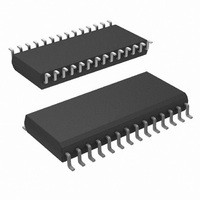COP8SGR728M7/NOPB National Semiconductor, COP8SGR728M7/NOPB Datasheet - Page 47

COP8SGR728M7/NOPB
Manufacturer Part Number
COP8SGR728M7/NOPB
Description
MCU 8BIT CMOS ROM OTP 28-SOIC
Manufacturer
National Semiconductor
Series
COP8™ 8SGr
Datasheet
1.COP8SGE728N8NOPB.pdf
(62 pages)
Specifications of COP8SGR728M7/NOPB
Core Processor
COP8
Core Size
8-Bit
Speed
15MHz
Connectivity
Microwire/Plus (SPI), UART/USART
Peripherals
POR, PWM, WDT
Number Of I /o
24
Program Memory Size
32KB (32K x 8)
Program Memory Type
OTP
Ram Size
512 x 8
Voltage - Supply (vcc/vdd)
2.7 V ~ 5.5 V
Oscillator Type
Internal
Operating Temperature
-40°C ~ 125°C
Package / Case
28-SOIC
Data Bus Width
8 bit
Maximum Clock Frequency
15 MHz
Data Ram Size
512 B
Number Of Programmable I/os
40
Number Of Timers
3
Height
2.34 mm
Interface Type
USART
Length
17.91 mm
Maximum Operating Temperature
+ 125 C
Minimum Operating Temperature
- 40 C
Supply Voltage (max)
5.5 V
Supply Voltage (min)
2.7 V
Width
7.49 mm
For Use With
COP8SG-EPU - BOARD PROTOTYPE/TARGET COP8
Lead Free Status / RoHS Status
Lead free / RoHS Compliant
Eeprom Size
-
Data Converters
-
Lead Free Status / Rohs Status
Details
Other names
COP8SGR728M7
14.0 Instruction Set
14.1 INTRODUCTION
This section defines the instruction set of the COP8 Family
members. It contains information about the instruction set
features, addressing modes and types.
14.2 INSTRUCTION FEATURES
The strength of the instruction set is based on the following
features:
14.3 ADDRESSING MODES
The instruction set offers a variety of methods for specifying
memory addresses. Each method is called an addressing
mode. These modes are classified into two categories: op-
erand addressing modes and transfer-of-control addressing
modes. Operand addressing modes are the various meth-
ods of specifying an address for accessing (reading or writ-
ing) data. Transfer-of-control addressing modes are used in
conjunction with jump instructions to control the execution
sequence of the software program.
14.3.1 Operand Addressing Modes
The operand of an instruction specifies what memory loca-
tion is to be affected by that instruction. Several different
operand addressing modes are available, allowing memory
locations to be specified in a variety of ways. An instruction
can specify an address directly by supplying the specific
address, or indirectly by specifying a register pointer. The
contents of the register (or in some cases, two registers)
point to the desired memory location. In the immediate
mode, the data byte to be used is contained in the instruction
itself.
Each addressing mode has its own advantages and disad-
vantages with respect to flexibility, execution speed, and
program compactness. Not all modes are available with all
instructions. The Load (LD) instruction offers the largest
number of addressing modes.
• Mostly single-byte opcode instructions minimize program
• One instruction cycle for the majority of single-byte in-
• Many single-byte, multiple function instructions such as
• Three memory mapped pointers: two for register indirect
• Sixteen memory mapped registers that allow an opti-
• Ability to set, reset, and test any individual bit in data
• Register-Indirect LOAD and EXCHANGE instructions
• Unique instructions to optimize program size and
size.
structions to minimize program execution time.
DRSZ.
addressing, and one for the software stack.
mized implementation of certain instructions.
memory address space, including the memory-mapped
I/O ports and registers.
with optional automatic post-incrementing or decrement-
ing of the register pointer. This allows for greater effi-
ciency (both in cycle time and program code) in loading,
walking across and processing fields in data memory.
throughput efficiency. Some of these instructions are
DRSZ, IFBNE, DCOR, RETSK, VIS and RRC.
47
The available addressing modes are:
The addressing modes are described below. Each descrip-
tion includes an example of an assembly language instruc-
tion using the described addressing mode.
Direct. The memory address is specified directly as a byte in
the instruction. In assembly language, the direct address is
written as a numerical value (or a label that has been defined
elsewhere in the program as a numerical value).
Example: Load Accumulator Memory Direct
Register B or X Indirect. The memory address is specified
by the contents of the B Register or X register (pointer
register). In assembly language, the notation [B] or [X] speci-
fies which register serves as the pointer.
Example: Exchange Memory with Accumulator, B Indirect
Register B or X Indirect with Post-Incrementing/
Decrementing. The relevant memory address is specified
by the contents of the B Register or X register (pointer
register). The pointer register is automatically incremented
or decremented after execution, allowing easy manipulation
of memory blocks with software loops. In assembly lan-
guage, the notation [B+], [B−], [X+], or [X−] specifies which
register serves as the pointer, and whether the pointer is to
be incremented or decremented.
Example: Exchange Memory with Accumulator, B Indirect
Intermediate. The data for the operation follows the instruc-
tion opcode in program memory. In assembly language, the
number sign character ( # ) indicates an immediate operand.
• Direct
• Register B or X Indirect
• Register B or X Indirect with Post-Incrementing/
• Immediate
• Immediate Short
• Indirect from Program Memory
Decrementing
Memory Location
Memory Location
Memory Location
Accumulator
Accumulator
Accumulator
LD A,05
X A,[B]
with Post-Increment
X A,[B+]
Reg/Data
0005 Hex
Reg/Data
0005 Hex
Reg/Data
0005 Hex
B Pointer
B Pointer
Memory
Memory
Memory
Contents
Contents
Contents
XX Hex
A6 Hex
Before
Before
01 Hex
87 Hex
05 Hex
Before
03 Hex
62 Hex
05 Hex
Contents
Contents
Contents
A6 Hex
A6 Hex
87 Hex
01 Hex
05 Hex
62 Hex
03 Hex
06 Hex
After
After
After
www.national.com










